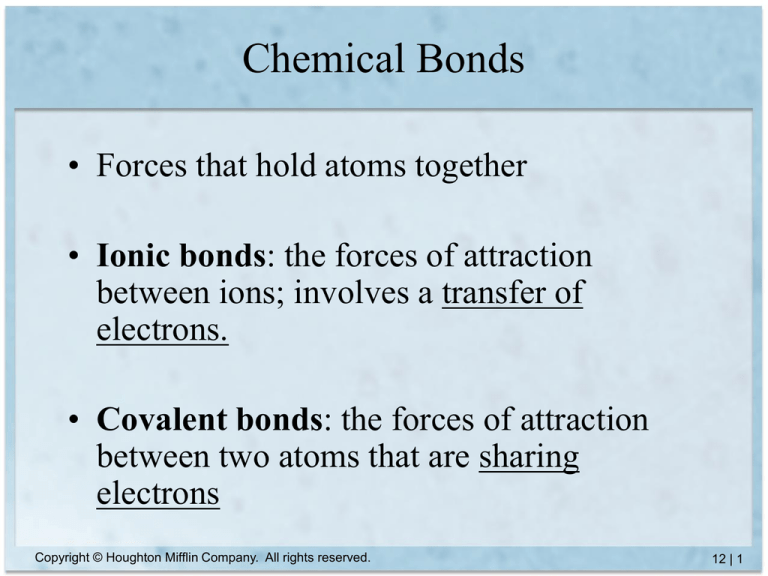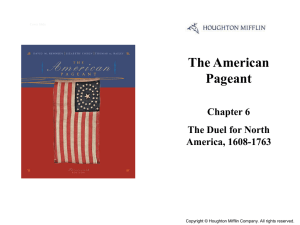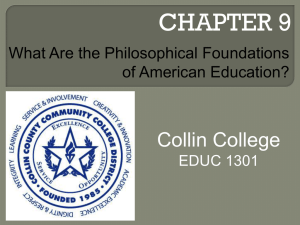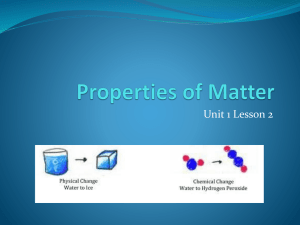
Chemical Bonds
• Forces that hold atoms together
• Ionic bonds: the forces of attraction
between ions; involves a transfer of
electrons.
• Covalent bonds: the forces of attraction
between two atoms that are sharing
electrons
Copyright © Houghton Mifflin Company. All rights reserved.
12 | 1
Ionic Bonds
• Result from reaction between metal and
nonmetal to form a cation and an anion
• An ionic bond is the attraction between a
positive ion and negative ion.
• The ions are arranged in a pattern called a
crystal lattice.
Copyright © Houghton Mifflin Company. All rights reserved.
12 | 2
Crystal Structures
sodium chloride
Copyright © Houghton Mifflin Company. All rights reserved.
12 | 3
Covalent Bonds
• Sharing pairs of electrons
• Molecules attracted to each other weakly
• Often found between nonmetal atoms
N2
Cl2
HF
Copyright © Houghton Mifflin Company. All rights reserved.
12 | 4
Bond Polarity
• Covalent bonding between unlike atoms
results in unequal sharing of the electrons.
• The result is bond polarity; HF
H •• F
Copyright © Houghton Mifflin Company. All rights reserved.
12 | 5
Electron Sharing in HF
If electrons were equally shared
Copyright © Houghton Mifflin Company. All rights reserved.
Actual molecule
12 | 6
Electronegativity
• Measure of the inherent ability of an atom to attract shared
electrons
• A larger electronegativity means that an atom attracts shared
electrons more strongly; fluorine in HF
• The difference in electronegativity between two atom in a bond is
a measure of bond polarity. A larger difference in electronegativity means a more polar bond.
If the difference is ≥2, the bond is ionic
If the difference is >0 and <2, the bond is polar covalent
If the difference is 0, the bond is covalent
Copyright © Houghton Mifflin Company. All rights reserved.
12 | 7
Electronegativity (cont.)
Copyright © Houghton Mifflin Company. All rights reserved.
12 | 8
Choose the bond in each pair that will be more polar.
• H-P or H-C:
• O-F or O-I:
• N-O or S-O:
• N-H or Si-H:
Copyright © Houghton Mifflin Company. All rights reserved.
12 | 9
Classify the following bonds as ionic,
covalent, or polar covalent
•
•
•
•
•
HCl
NaF
Cl2
Cl-F
NH3
Copyright © Houghton Mifflin Company. All rights reserved.
12 | 10
Dipole Moment
• Any molecule that has a center of positive
charge and a center of negative charge at
different points in space is said to have a
dipole moment.
H-F
Copyright © Houghton Mifflin Company. All rights reserved.
12 | 11
Dipole Moment (cont.)
• In polyatomic molecules the dipole
moment depends upon the atoms involved
and the three-dimensional structure.
H
H
O
H
Copyright © Houghton Mifflin Company. All rights reserved.
O
H
12 | 12
Dipole Moment (cont.)
The dipole moment affects the attractive forces between
molecules, and therefore the physical properties of the
substance. For example, water readily dissolves NaCl.
Copyright © Houghton Mifflin Company. All rights reserved.
12 | 13
Electron Arrangements
and Ionic Bonding
• Metals lose their valence electrons to form cations.
• Nonmetals gain electrons to form anions.
• Both try to acquire the electron configuration of a
noble gas; for example, NaCl
Na: [Ne]3s1
→
[Ne] + 1eCl: [Ne]3s23p5 + 1e- → [Ar]
Copyright © Houghton Mifflin Company. All rights reserved.
12 | 14
What are the electron configurations of the
ions in the following compounds?
• Al2S3
• MgO
• SrF2
• LiCl
Copyright © Houghton Mifflin Company. All rights reserved.
12 | 15
Electron Arrangements
and Ionic Bonding (cont.)
• Formulas are predicted by achieving electrical
neutrality using the component cations and anions.
What is the formula of the ionic compound formed from
Al and S?
• In polyatomic ions, the atoms in the ion are
connected with covalent bonds. The ions are
attracted to oppositely charged ions to form an
ionic compound.
Copyright © Houghton Mifflin Company. All rights reserved.
12 | 16
Properties of Ionic Compounds
• All are solids at room temperature.
– Melting points are greater than 300°C.
• Many are soluble in water. When dissolved
the solution becomes an electrical conductor.
Copyright © Houghton Mifflin Company. All rights reserved.
12 | 17
Bonding & Structure
of Ionic Compounds
• Crystal lattice: geometric pattern determined by the
size and charge of the ions.
• Anions are almost always larger than cations.
• Anions are generally considered “hard” spheres
packed as efficiently as possible, with the cations
occupying the “holes” in the packing.
• Compounds with polyatomic anions contain covalent
bonds within the anion structure, which are ionically
bonded to the cation; CuSO4
Copyright © Houghton Mifflin Company. All rights reserved.
12 | 18
Copper(II) sulfate
Cu2+
Copyright © Houghton Mifflin Company. All rights reserved.
SO4212 | 19
Lithium fluoride
Copyright © Houghton Mifflin Company. All rights reserved.
12 | 20
Lewis Structures
• Use the symbol of the element to represent the
nucleus and inner electrons.
• Use dots around the symbol to represent valence
electrons.
• Elements try to achieve a noble gas configuration.
sodium chloride
Copyright © Houghton Mifflin Company. All rights reserved.
12 | 21
Lewis Structures (molecules with covalent bonds)
•
Hydrogen shares two electrons (duet rule).
• Helium already has two, so it does not form bonds.
• The second row nonmetals require eight electrons to
fill the 2s and 2p orbitals (octet rule).
example: Cl2
•
Neon has eight electrons, so it does not form bonds.
Copyright © Houghton Mifflin Company. All rights reserved.
12 | 22
Writing Lewis Structures of Molecules
• Count the total number of valence electrons from all
the atoms.
• Attach the atoms together with one pair of electrons.
• Arrange the remaining electrons in pairs so that all
hydrogen atoms have two electrons (one bond) and
other atoms have eight electrons (combination of
bonding and nonbonding). Nonbonding pairs of
electrons are also know as lone pairs.
Copyright © Houghton Mifflin Company. All rights reserved.
12 | 23
Draw Lewis structures for the following molecules:
• NH3
• CCl4
• LiBr
• CH3OH
Copyright © Houghton Mifflin Company. All rights reserved.
12 | 24
Multiple Covalent Bonds
• Single covalent bond: atoms share two
electrons (one pair); HBr
• Double covalent bond: atoms share four
electrons (two pairs); C2H4
• Triple covalent bond: atoms share six
electrons (three pairs); HCN
Copyright © Houghton Mifflin Company. All rights reserved.
12 | 25
Lewis Structures of Molecules with
Multiple Bonds
• Determine the total number of valence
electrons.
• Form a single bond around each atom.
• Distribute the remaining electrons.
• Make double or triple bonds as needed until
each atom (except H) acquires an octet of
electrons.
Copyright © Houghton Mifflin Company. All rights reserved.
12 | 26
Draw Lewis structures for the following molecules:
• CO2
• NO3-1
• HCO3-1
• SO3
Copyright © Houghton Mifflin Company. All rights reserved.
12 | 27
Resonance
• When there are multiple Lewis structures for a
molecule that differ only in the positions of the
electrons, they are called resonance structures.
(Lone pairs and multiple bonds are in different
positions.) The real structure is a hybrid.
NO3-1
Copyright © Houghton Mifflin Company. All rights reserved.
12 | 28
Draw resonance structures for HCO3-1
Copyright © Houghton Mifflin Company. All rights reserved.
12 | 29
Exceptions to the Octet Rule
Some atoms may violate the octet rule.
beryllium: forms two bonds; BeCl2
boron and aluminum: normally form three bonds; BH3, AlCl3
phosphorus: can form up to five bonds; PCl5
sulfur: can form up to six bonds; SF6
Copyright © Houghton Mifflin Company. All rights reserved.
12 | 30
Molecular Structure
• Refers to the three-dimensional geometry of a molecule.
• Can specify a bond angle.
120°
• We will consider five different structures:
- linear
- trigonal planar
- tetrahedral
- trigonal pyramid
- bent
Copyright © Houghton Mifflin Company. All rights reserved.
12 | 31
Molecular Structure (cont.)
180°
• Linear: BeCl2
• Trigonal planar: BH3
120°
109.5°
• Tetrahedral: CCl4
Copyright © Houghton Mifflin Company. All rights reserved.
12 | 32
• Trigonal pyramid: NH3
• Bent: H2O
Copyright © Houghton Mifflin Company. All rights reserved.
12 | 33
Predicting Molecular Structure
• VSEPR Theory
– Valence Shell Electron Pair Repulsion
• The shape around the central atom can be predicted
by assuming that the electrons surrounding the
central atom will position themselves as far apart as
possible.
BeCl2
Copyright © Houghton Mifflin Company. All rights reserved.
12 | 34
Steps for Predicting Molecular Structure
• Draw the correct Lewis structure.
• Count the electron pairs and place them as far
apart as possible.
• Determine the positions of the atoms.
• Determine the name of the molecular structure
based on the positions of the attached atoms.
Copyright © Houghton Mifflin Company. All rights reserved.
12 | 35
Determine the molecular structures of the
following molecules:
• NH3
• CCl4
• AlCl3
• BeF2
Copyright © Houghton Mifflin Company. All rights reserved.
12 | 36
• Some molecules contain a combination of
more than one shape.
CH3OH
Copyright © Houghton Mifflin Company. All rights reserved.
12 | 37
Molecules with Multiple Bonds
• When using the VSEPR model to predict the
molecular geometry, multiple bonds are
counted the same as a single electron pair.
CO2
HCN
Copyright © Houghton Mifflin Company. All rights reserved.
12 | 38







